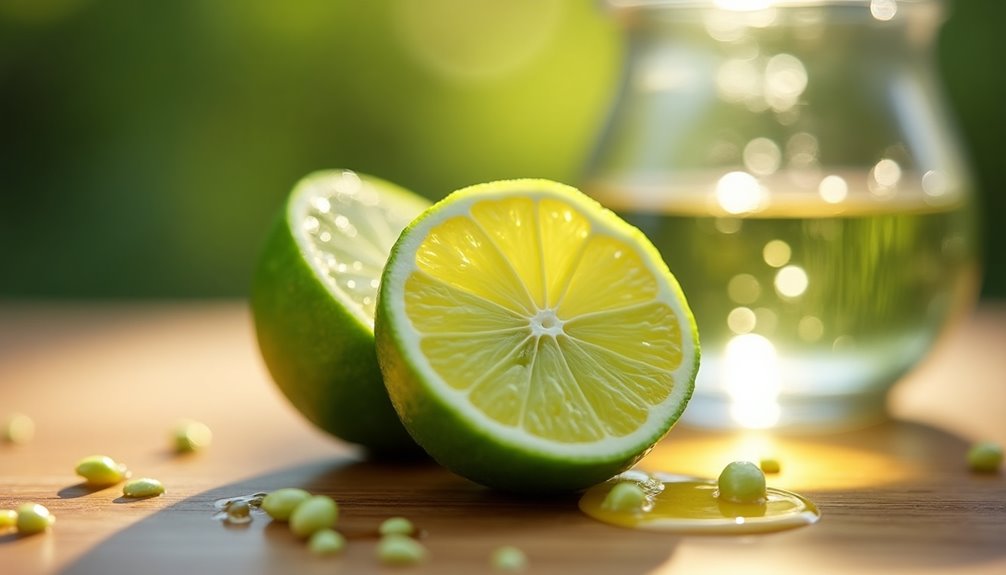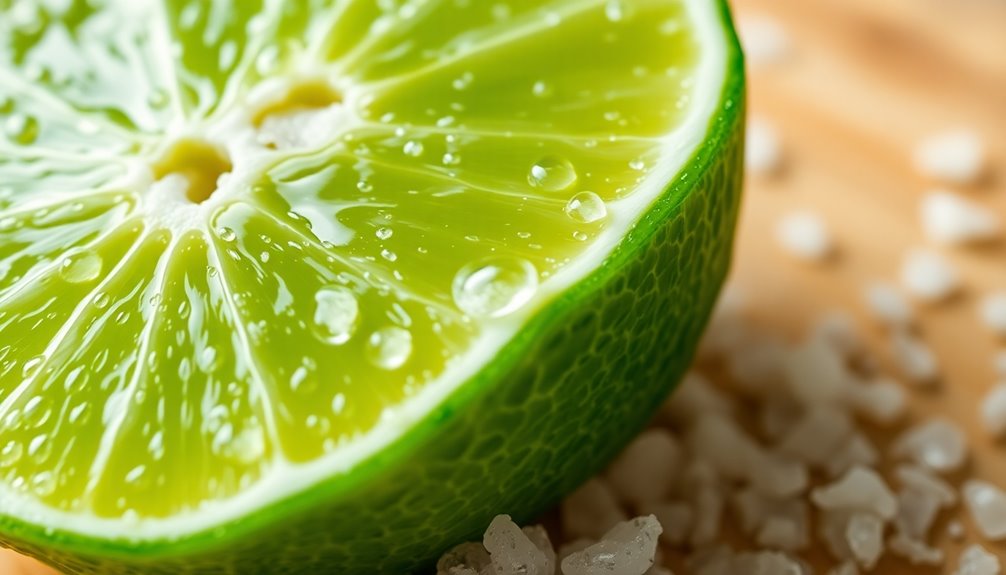A medium lime usually gives you about 2 tablespoons of juice, while smaller limes yield around 1 tablespoon, and larger ones can produce up to 3 tablespoons. If you're planning recipes that require lime juice, knowing this can help you estimate how many limes you'll need. Having a few extra limes on hand is a smart move, especially for cocktails or marinades. Stick around to discover tips for shopping and using lime juice effectively!
Key Takeaways
- A medium lime typically produces about 2 tablespoons (1 ounce) of juice.
- Smaller limes yield approximately 1 tablespoon of juice each.
- Larger limes can provide up to 3 tablespoons of juice.
- Juice yield varies based on the size of the lime.
- Having extra limes is advisable to ensure sufficient juice for recipes.

Have you ever wondered how much juice you can squeeze from a lime? It's a common question for anyone who loves cooking or mixing drinks. Knowing the juice yield from a lime can help you nail down your recipes, ensuring you get just the right amount of that zesty flavor. When you're in the kitchen, it's always handy to have a rough idea of how much juice you can expect from this popular citrus fruit.
Typically, a medium lime produces about 2 tablespoons, or 1 ounce, of fresh lime juice. If you've got smaller limes on hand, don't be surprised if they yield only around 1 tablespoon. On the other hand, larger limes can surprise you with a generous yield of up to 3 tablespoons. This variability means that when you're planning your recipes, it's essential to consider the size of the limes you're using. It's always a good idea to have a few extras just in case!
For recipes that call for 1/4 cup of lime juice, you'll generally need about 2 medium limes. If you're squeezing limes for a refreshing cocktail or a zesty marinade, knowing how many limes to grab can save you time and effort. You wouldn't want to run out of juice halfway through preparing your favorite guacamole or limeade, would you?
When you're shopping for limes, you might notice that they're often sold by the pound. On average, a pound of limes yields about 8 to 10 tablespoons, or roughly 1/2 to 2/3 cup of juice. This estimate is incredibly useful for meal prepping or when you're hosting a gathering. If you're planning to whip up a big batch of a lime-based recipe, you can easily calculate how many pounds of limes you'll need based on the expected yield.
What's great about lime yields is that they tend to be consistent across different limes. This consistency makes it easier to estimate how many limes you'll need for various recipes. If you're experimenting with flavors or trying out new recipes, knowing that a medium lime typically gives you 2 tablespoons of juice allows you to scale up or down with confidence.
Incorporating fresh lime juice into your dishes elevates them, adding a bright, tangy flavor that complements many ingredients. Whether you're baking, grilling, or crafting cocktails, the right amount of lime juice can truly make a difference.
Frequently Asked Questions
How Much Juice Is in 2 Limes?
When you juice two medium limes, you can expect to get about 4 tablespoons of juice, which is roughly 1/4 cup. This amount can vary slightly based on the freshness and size of the limes. If you’re wondering how much juice in one lime, typically, you can anticipate about 2 tablespoons, which would make it easier to measure if you’re only using one. So, for recipes that require lime juice, keep this conversion in mind to ensure you have just the right amount for your dish or drink.
Each lime typically yields around 2 tablespoons, so that totals about 2 ounces of juice.
Keep in mind that the actual amount may vary slightly depending on the size and ripeness of the limes you're using, but two limes should generally meet your needs for most recipes requiring lime juice.
How Much Juice Does 1 Lime Yield?
When you're juicing a lime, you can expect about 2 tablespoons of juice from one medium lime, which is roughly 1 ounce.
However, this can vary based on the lime's size and ripeness. If you're using smaller limes, you might get around 1 tablespoon, while larger ones could yield up to 3 tablespoons.
To get the most juice, try rolling the lime or warming it slightly before juicing.
How Much Real Lime Equals 1 Lime?
When you're trying to figure out how much real lime equals one lime, it typically relates to the juice yield.
One medium lime gives you about 2 tablespoons of juice, which is roughly 1 ounce. If a recipe calls for lime juice, you can estimate that you'll need one lime to equal that measurement.
Keep in mind that the exact amount can vary slightly based on the lime's size and ripeness.
How Many Tsp Is 2 Limes?
If you think two limes can yield just a splash, think again!
You're looking at about 12 teaspoons of zesty lime juice when you squeeze those beauties. That's enough to elevate your guacamole to legendary status or make your margaritas sing!
Conclusion
In the end, one lime typically yields about two tablespoons of juice, perfect for adding that zesty kick to your dishes or drinks. Remember, "when life gives you limes, make margaritas!" So, next time you're squeezing a lime, think of all the delicious possibilities. Whether you're enhancing a recipe or mixing a refreshing beverage, a little lime juice can go a long way in elevating your culinary creations. Enjoy the burst of flavor!
Cindy thoroughly researches juicing trends, techniques, and recipes to provide readers with practical advice and inspiration. Her writing style is accessible, engaging, and designed to make complex concepts easy to understand. Cindy’s dedication to promoting the advantages of juicing shines through her work, empowering readers to make positive changes in their lives through the simple act of juicing.











